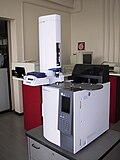Inverse gas chromatography is a physical characterization analytical technique that is used in the analysis of the surfaces of solids. Inverse gas chromatography...
13 KB (1,760 words) - 23:53, 23 December 2023
Gas chromatography (GC) is a common type of chromatography used in analytical chemistry for separating and analyzing compounds that can be vaporized without...
38 KB (5,022 words) - 19:44, 1 May 2025
High-performance liquid chromatography (HPLC), formerly referred to as high-pressure liquid chromatography, is a technique in analytical chemistry used...
89 KB (10,969 words) - 20:19, 22 May 2025
Size-exclusion chromatography (SEC) Affinity chromatography Centrifugal partition chromatography Gas chromatography and Inverse gas chromatography Crystallization...
8 KB (936 words) - 04:17, 28 May 2025
surrounded by water or other liquids. Inverse gas chromatography is a technique which studies the interaction of gases and vapours with a surface - measurements...
13 KB (1,753 words) - 12:35, 6 September 2024
provisional government of Iraq from July 13, 2003 to June 1, 2004 Inverse gas chromatography, an analytical technique in the analysis of the surfaces of solids...
3 KB (330 words) - 07:37, 6 September 2023
surface properties of the metakaolins can be characterized by inverse gas chromatography analysis. Considered to have twice the reactivity of most other...
9 KB (1,070 words) - 22:51, 26 December 2024
Colin F. (2015-11-20). "Ionization-based detectors for gas chromatography". Journal of Chromatography A. Instrumentation and Automation for the Separation...
3 KB (315 words) - 22:57, 23 May 2025
Boyle's law (category Gas laws)
by a given mass of an ideal gas is inversely proportional to the volume it occupies if the temperature and amount of gas remain unchanged within a closed...
18 KB (2,300 words) - 22:05, 21 January 2025
example, gas chromatography-mass spectrometry, gas chromatography-infrared spectroscopy, liquid chromatography-mass spectrometry, liquid chromatography-NMR...
36 KB (4,120 words) - 01:54, 26 May 2025
Lundström, Jan; Agurell, Stig (1967). "Thin-layer chromatography of the peyote alkaloids". Journal of Chromatography A. 30 (1): 271–272. doi:10.1016/S0021-9673(00)84157-6...
4 KB (266 words) - 05:12, 21 May 2025
to gas chromatography–mass spectrometry for the analysis of polyphenols in herbal infusions, fruits and functional foods". Journal of Chromatography A...
9 KB (594 words) - 21:14, 23 May 2025
Tetrahymanol (section Gas chromatography)
be separated using gas chromatography. This technique separates molecules based on their polarity and size, which both inversely affect boiling point...
15 KB (1,605 words) - 04:24, 11 February 2024
Effusion (category Gases)
is given by the inverse ratio of the square roots of the masses of the gas particles. Rate of effusion of gas 1 Rate of effusion of gas 2 = M 2 M 1 {\displaystyle...
8 KB (1,280 words) - 14:35, 12 May 2025
as they are separated by a gas chromatograph. However this technique is little used compared to GC-MS (gas chromatography-mass spectrometry) which is...
37 KB (4,802 words) - 21:24, 23 May 2025
Nitrogen (redirect from Nitrogen gas)
in dioxin/polychlorinated biphenyl sample preparation". Journal of Chromatography A. 943 (2): 295–97. doi:10.1016/S0021-9673(01)01466-2. PMID 11833649...
104 KB (12,185 words) - 04:01, 5 May 2025
radio Inverse Doppler effect Inverse Faraday effect Inverse Problems Inverse Raman effect Inverse dynamics Inverse gas chromatography Inverse magnetostrictive...
13 KB (1,385 words) - 13:44, 11 July 2024
Pressure (section Pressure of an ideal gas)
and quantity, and inversely with volume: p = n R T V , {\displaystyle p={\frac {nRT}{V}},} where: p is the absolute pressure of the gas, n is the amount...
46 KB (5,784 words) - 16:09, 21 May 2025
techniques are used for this separation: capillary gas chromatography, high performance liquid chromatography, and capillary electrophoresis. Other technique...
23 KB (2,512 words) - 20:43, 29 May 2025
Monolithic HPLC column (category Chromatography)
or monolithic column, is a column used in high-performance liquid chromatography (HPLC). The internal structure of the monolithic column is created in...
34 KB (4,626 words) - 00:02, 31 January 2023
circular pipe of diameter D c {\displaystyle D_{c}} , the friction factor is inversely proportional to the Reynolds number alone (fD = 64/Re) which itself...
40 KB (5,142 words) - 14:09, 23 April 2025
{\displaystyle \chi (\mathbf {X} ,t)\,\!} , F {\displaystyle \mathbf {F} } has the inverse H = F − 1 {\displaystyle \mathbf {H} =\mathbf {F} ^{-1}\,\!} , where H...
50 KB (10,029 words) - 15:53, 27 May 2025
Magnus effect (section Inverse Magnus effect)
body but laminar flow on the other side. In these cases are called the inverse Magnus effect: the deflection is opposite to that of the typical Magnus...
29 KB (3,551 words) - 06:49, 24 April 2025
overview on univariate calibration, inverse regression, and detection limits: Application to gas chromatography/mass spectrometry technique". Mass Spectrometry...
12 KB (1,438 words) - 20:14, 29 May 2025
Post-column oxidation–reduction reactor (category Chromatography)
improve the quantitative measurement of organic analytes. It is used in gas chromatography (GC), after the column and before a flame ionization detector (FID)...
9 KB (1,350 words) - 20:15, 10 January 2025
Gladney, HM; Dowden, BF; Swalen, JD (1969). "Computer-Assisted Gas-Liquid Chromatography". Anal. Chem. 41 (7): 883–888. doi:10.1021/ac60276a013. Golubev...
17 KB (1,712 words) - 21:14, 4 April 2025
applied in gel permeation chromatography (GPC) also known as size exclusion chromatography (SEC). As with any chromatography it is used to separate mixtures...
13 KB (1,630 words) - 22:54, 27 May 2025
Capillary electrochromatography (category Chromatography)
a combination of two analytical techniques, high-performance liquid chromatography and capillary electrophoresis. Capillary electrophoresis aims to separate...
7 KB (924 words) - 12:02, 5 January 2024
Resistance R is proportional to the distance l between the electrodes and is inversely proportional to the cross-sectional area of the sample A (noted S on the...
30 KB (3,466 words) - 08:42, 25 May 2025
follows that the resistance R is inversely proportional to the fourth power of the radius r, i.e. the resistance R is inversely proportional to the second power...
37 KB (6,107 words) - 08:54, 21 May 2025
















